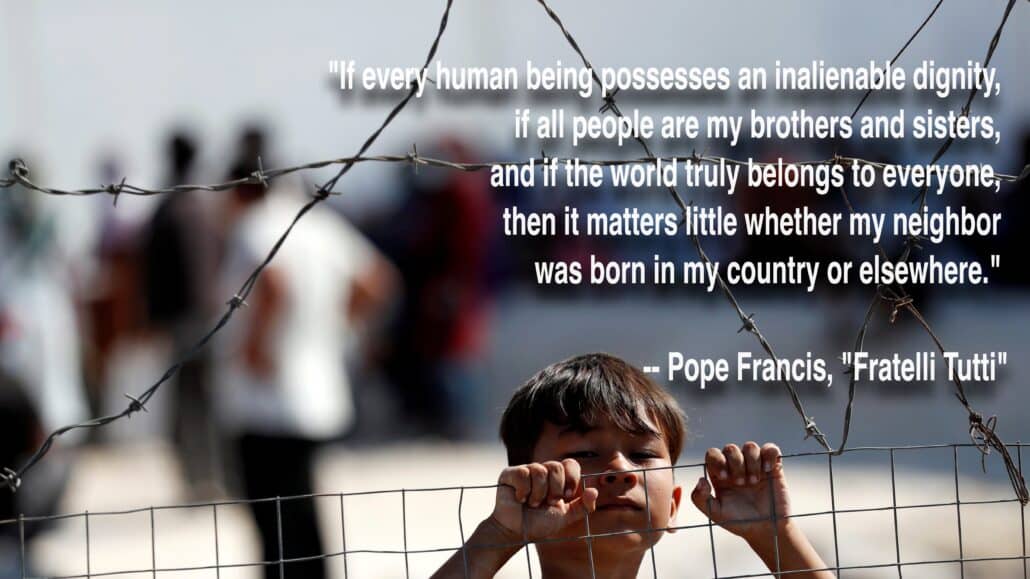Pope Francis stood beneath the tomb of St. Francis of Assisi on October 3rd and signed his new encyclical which opens with words of Francis himself. It was a touching moment.
This pope, formed to the marrow of his being in the Ignatian tradition, has channeled the authentic spirit of Francis of Assisi since taking that name upon his election as pontiff. In so doing, he has demonstrated a powerful synthesis of two major charisms within the Church, that of Francis of Assisi and Ignatius of Loyola. The pope’s discerning gifts have allowed him to see clearly what he must teach. It has also allowed him to incarnate anew the spirit of Francis which was one of rebuilding a damaged church and confronting the societal damages wrought by greed and war. He has, in effect, mobilized the preaching and spiritual counsels of Francis to support his own program of papal leadership.
Now we have the new encyclical in hand. Before it was available, however, the consternation about its title was being registered and a great deal of sadness and anger has been expressed by women with substantial credentials as Catholic teachers and advocates for women in our church. Their/our anguish over this point might have been prevented. One does not expect Pope Francis to possess encyclopedic knowledge of Franciscan texts and primary sources. However, Rome is home to a number of such experts and it is most unfortunate that one with both knowledge of the saint’s writings and experience with English translations was not consulted.
What is the normal practice in writing these documents?
An encyclical is referred to by the first two words of the document. These introductory words are known as the “incipit.” The title may be a much longer phrase but is rarely used since most will use the two word “incipit”—Humane vitae, Rerum novarum, etc. For example, the encyclical we call “Laudato si’” has as its formal title: “On Care for our Common Home.” While this may seem like a minor item, it indicates that while formal titles are given, the customary form of reference will be the use of those two initial words. Compounding the problem of the “incipit,” of the new encyclical, its longer title, “On the Fraternity and Social Relationships,” compounds the problem.
In a recent dispatch to the NCR, Vatican correspondent, Gerald O’ Connell, stated that the first two words, “Fratelli tutti” come from the Admonitions of St. Francis and that it was using this quotation of another’s words that led to the title being thus limited. Indeed, the footnote offered for this phrase cites Admonition VI, which was addressed only to the friars, not as the pope’s opening sentence states, to all “brothers and sisters.” Here, someone versed in the original Latin of Francis’ writings (and the best of English translations) could have advised Pope Francis and this would have prevented this unfortunate situation.
In fact, the choice of Admonition VI would have been strange indeed since its contents in no way correspond to the message of Fratelli tutti. That particular “warning” of Francis was a sort of scolding reminder to the brothers who were preachers to be sure that they lived the radical holiness about which they were preaching to others. Clerical homiletic excess is not the theme of this papal teaching.
When St. Francis addressed his gathered friars, he addressed them as “omnes fratres”—“all my brothers.” When he addressed St. Clare and her sisters, he addressed them as “daughters and handmaids” (“filias et ancillas”) of God. In his final message to the sisters, he addressed them as “my ladies” (“dominas meas.)” (This was a touching homage to the noble status of many of the sisters.) When he intends all men and women—as he does in two early documents directed to lay followers—he addresses both sexes clearly: “illi et illae” or “men and women.” In other words, the medieval saint did distinguish to whom he was speaking or writing. When he intended women as recipients, the Latin texts were clear.
Did Pope Francis recognize what would happen when the protocol of using those two initial words as a “title” was published? It does not seem consistent with his own practice, nor with the spirit of pastoral outreach. At least one commentator has noted that while Pope Francis has shown considerable respect for women and would not knowingly exclude them, his advisors may have been less anxious to show such linguistic deference. This, I believe, is a very trenchant point.
His model, Francis of Assisi, created an inclusive movement to renew the Christian faithful. Pope Francis clearly seeks to channel that charismatic inspiration anew in our time. Let’s give the new encyclical our careful attention and join in the conversations it will provoke so as to harvest its critically important teaching. We can and must do this without losing our own commitment to the advancement of women in the Church—including Vatican posts of importance and influence.
Click here for more on Fratelli Tutti!








